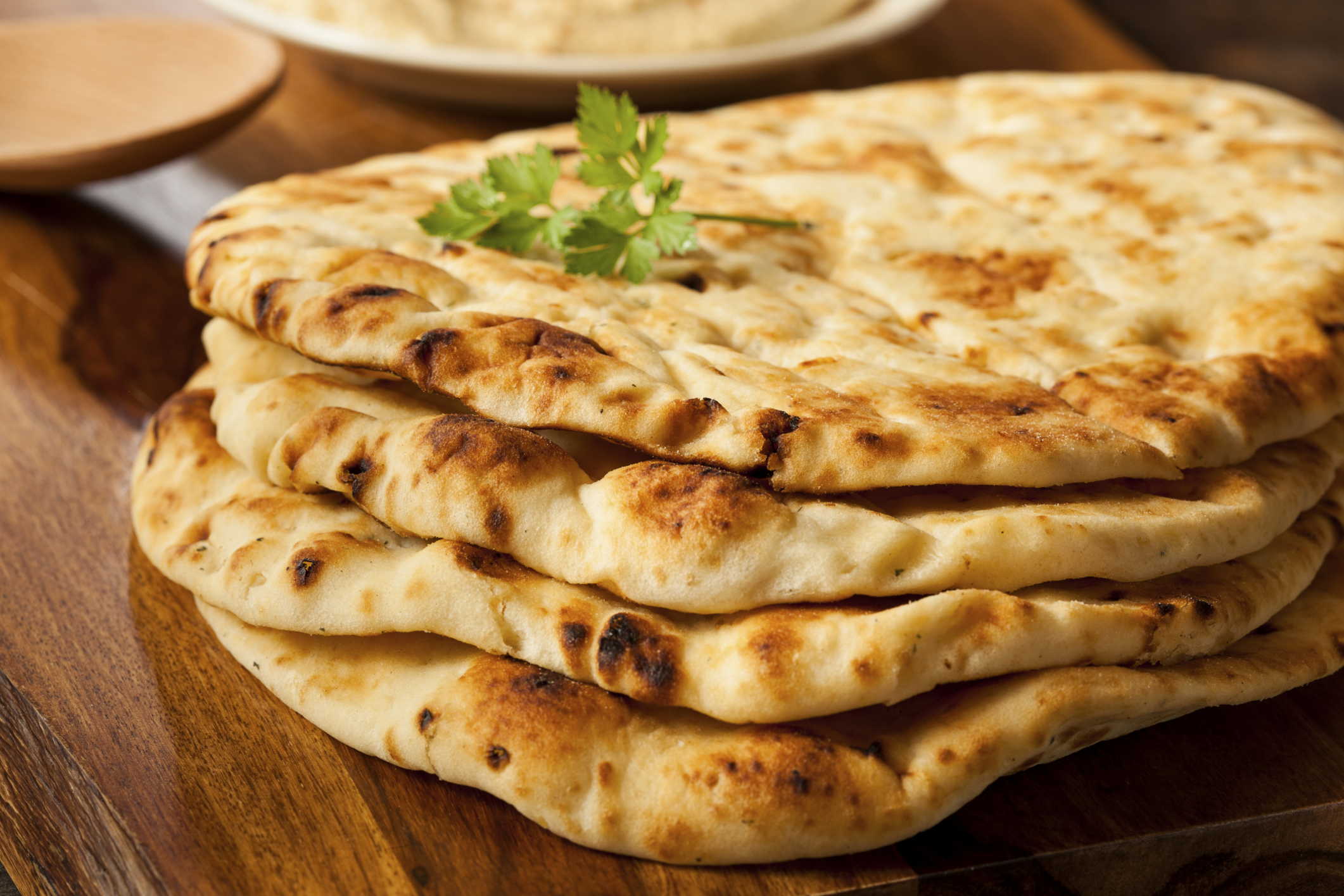Flatbread can be made from nearly every grain imaginable: wheat, rye, corn, oats and even tubers or legumes such as potatoes, chickpeas, or lentils. It can be leavened or unleavened and made so thin that they become transparent or it can be two inches thick and sliceable. Flatbreads can be oven baked, steamed, fried, grilled, or even, as in southern Algeria and Tunisia, baked by the desert sands (Alford and Duguid 4). Since flatbreads can be so diverse in their ingredients and baking methods it is no wonder they are found all over the globe in almost every culture.
Flatbread is the oldest form of bread and it has been produced for over 11,000 years. There is some dispute among experts as to the exact origin of flat bread but it is agreed that the first flatbreads developed in the fertile crescent 14.6 to 11.6 thousand years ago. Anthropologist Amaia Arranz-Otaegui and her associates believe that flatbread was first created at an archeological site Shubayqa 1, Shubayqa 1 is a hunter-gatherer site dated to the early and late Natufian era located in northeast Jordan, in an area known as the Black Desert (Arranz-Otaegui et al.). As a food scientist, Antonella Pasqualone, believes that flatbreads developed independently in several geographical areas: the Fertile Crescent, sub-Sahara, Ethiopia, China, New Guinea, Mesoamerica, Amazonia, Andes, and eastern United States, with the fertile crescent being the first but unattriubtable to a specific site. After its initial creation in the fertile crescent flatbreads diffused across the world; “flatbreads spread westward around the Mediterranean, across North Africa and southern Europe, northward across the Anatolian peninsula to the Balkans and to Central Asia, and eastward to India” (Pasqualone).
The fact that flatbread has spread so far and remained a relevant dish can be attributed to certain characteristics of flatbreads. Pasqualone states that flatbreads do not always require an oven, as mentioned before they can be baked in hot sand or over fire. Flatbreads can also contain food or can be used and as a utensil itself. Other features such as its shelf life and size are important. Flatbreads can be dehydrated and extend their shelf life and since they are flatter they can be easily transported in larger quantities.
The convenience of flatbreads is enjoyed around the world and it is a food that has grown to become instrumental in the diets of many people; “In countries across North Africa, the Middle East, and Asia, where flatbreads are a major source of calories, the nutritional contribution of these products is extremely important”(Quail). Not only are flatbreads a major source of nutrition they have become an integral piece in the dishes of many cultures. Flatbreads were first made thousands of years ago but because of their diversity in ingredients and cooking methods, and the qualities that they contain, flatbreads continue to be culturally important foods all over the world.
Works Cited
Abitbol, Vera. “Israel: Pita Bread.” 07 Apr. 2020. Web. 02 Dec. 2020.
Alford, Jeffery, and Naomi Duguid. 1995. Flatbreads and flavors : a baker’s atlas. N.p.: HarperCollins..
Arranz-Otaegui, Amaia, Lara Gonzalez Carretero, Monica N. Ramsey, Dorian Q. Fuller, and Tobias Richter. 2018. “Archaeobotanical evidence reveals the origins of bread 14,400 years ago in northeastern Jordan.” Proceedings of the National Academy of Sciences of the United States of America 115 (31): 7925-7930. https://www.pnas.org/content/115/31/7925.
Bank Muñoz, Carolina. 2008. “The Political Economy of Corn and Tortillas.” In Transnational Tortillas: Race, Gender, and Shop-Floor Politics in Mexico and the United States, 24-37. N.p.: Cornell University Press. www.jstor.org/stable/10.7591/j.ctt7zfnv.5.
Davidson, Alan, Tom Jaine, and Soun Vannithone. The Oxford Companion to Food. New York, NY: Oxford UP, 2014. Print.
Jayasanker, Laresh. 2020. “Tortilla Politics.” In Sameness in Diversity: Food and Globalization in Modern America, 125-142. 1st ed. Vol. 72. Oakland, California: University of California Press. 10.2307/j.ctvx1hv29.14.
Harris, Mark Anglin, and Charles Kofi Koomson. “Moisture‐Pressure Combination Treatments for Cyanide Reduction in Grated Cassava.” Wiley Online Library. John Wiley & Sons, Ltd, 06 Jan. 2011. Web. 01 Dec. 2020.
Kraig, Bruce, and Colleen Taylor. Street Food around the World: An Encyclopedia of Food and Culture. Santa Barbara, CA: ABC-CLIO, 2013. Print.
Neela, Satheesh, and Solomon W. Fanta. 2020. “Injera (An Ethnic, Traditional Staple Food of Ethiopia): A review on Traditional Practice to Scientific Developments.” Journal of Ethnic foods 7, no. 32 (September). https://doi.org/10.1186/s42779-020-00069-x.
Pasqualone, Antonella. 2018. “Traditional flat breads spread from the Fertile Crescent: Production process and history of baking systems.” Journal of Ethnic Foods 5, no. 1 (March): 10-19. https://doi.org/10.1016/j.jef.2018.02.002.
Pasqualone, Antonella, Debora Delcurato, and Tommaso Gomes. “Chapter 5 – Focaccia Italian Flat Fatty Bread.” Academic Press (2011): 47-58. Print.
Pelligrino, S., and Acqua Panna. “Australian Damper Bread.” Fine Dining Lovers. 22 July 2015. Web. 02 Dec. 2020.
Revas Alfonzo, Bertha. “El Casabe Y La Arepa: Alimentos Prehispánicos De La Culinaria Indígena Venezolana.” Revista De Turismo Y Patrimonio Cultural 12.2 (2014): 433-42. PASOS. 2014. Web. 2 Dec. 2020.
Tan, Althea. “Beginner’s Guide to Indian Breads: 7 Types to Start With.” MICHELIN Guide. Michelin, 10 Oct. 2017. Web. 02 Dec. 2020.
Quail, K.J. 2016. Flatbreads of the World. 2nd ed. Vol. 3. N.p.: Encyclopedia of Food and Grains. https://www.sciencedirect.com/topics/food-science/flat-breads. 15 Oct. 2020.
